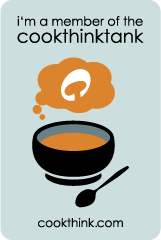Thinking about it, I decided that I had left something critical out of the instructions for mayonnaise. It has to do with the ways of getting the emulsion to hang together. Originally, it was done by the force of the wrist and still can be. I have even seen ancient recipes for making mayonnaise on a platter and whipping it by constantly stirring along the flat of the platter with a fork. The fork was slid along the platter and then lifted slightly in the air. This whisking would go on until the emulsion formed. It can be done. I did it out of curiousity.
Fortunately some fine person invented the whisk composed of many wires bent into a balloon or oval shape with both ends of the wires stuck into a handle. This is a vast improvement; but lesson can be learned from the more primitive method. It is better to use a widish rather than a deep bowl and to move the whisk in a low oval. I don't really like the rotary egg beater; it doesn't incorporate enough air.
More recent times have brought us mechanical--electric--help in the form first of blenders and later food processors. In both cases, the powerful motors force the eggs and oil together and the trick is done. Incidentally the same thing is true for Hollandaise. the difference being that melted butter is used instead of oil and it is made over low heat stabilizing it even further.
technically, there is a difference in the way that the blender and the food processor should be used.
Start in any case with room-temperature ingredients. The blender will go more quickly and so must the cook. To keep it from going too quickly, some liquid--usually the acid, lemon juice or vinegar--should be added to the eggs along with the salt which breaks down the yolks a little. Run the blender at high speed continuously until uniform. Now, pour in the oil in a steady stream. Do not slow down or stop. The food processor is a little more forgiving and will permit the cook to slow down or even pick up the phone once the emulsion has started using only the eggs and the salt. The acid should be added about half way through the process.
The yolks of chicken egg s are traditional; but whole eggs, egg whites alone (for the allergic and diet conscious), and various fish eggs can be used instead.
My book, Roasting, has a basic mayonnaise on page 303. The sadly out of print, Microwave Gourmet Healthstyle has an egg white mayonnaise on page 482. That was created to cut down on cholesterol. I will be glad to give more information if requested. I can also post the book recipes to the recipe section of the blog. Do remember the poor__especially these days--author.
Subscribe to:
Post Comments (Atom)


2 comments:
Thanks for the details and the pointer to the roasting cookbook. I've placed my order with Amazon. I think I will pass on the platter method, but someday I will try to make aioli without any eggs at all, just to see if I can do it.
It can be done; but it is a lot of work and needs a big mortar and heavy pestle. Mildly cheating is a little cooked potato. Did this when I gave a class with James Beard.
Post a Comment